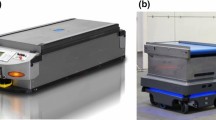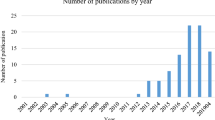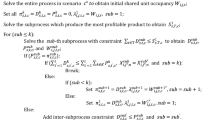Abstract
Here, an approach for finding an optimal path in a flexible jobshop manufacturing system considering two criteria of time and cost is proposed. A network is configured in which the nodes are considered to be the shops with arcs representing the paths among the shops. An automated guided vehicle functions as a material handling device through the manufacturing network. To account for uncertainty, time is considered to be a triangular fuzzy number and apply an expert system to infer the cost. The expert system based on fuzzy rule backpropagation network to configure the rules for estimating the cost under uncertainty is proposed. A multiple linear regression model is applied to analyze the rules and find the effective rules for cost estimation. The objective is to find a path minimizing an aggregate weighted unscaled time and cost criteria. A fuzzy dynamic programming approach is presented for computing a shortest path in the network. Then, a comprehensive economic and reliability analysis is worked out on the obtained paths to find the optimal producer’s behavior. Finally, an application of the model is illustrated by a numerical example. The results show the effectiveness of our approach for finding an optimal path in a manufacturing system under uncertainty.
Similar content being viewed by others
References
Abdel-Malek L, Wolf C (1991) Evaluating flexibility of alternative FMS designs—a comparative measure. Int J Prod Econ 23(1):3–10
Abdi H, Valentin D, Edelman B, O’Toole AJ (1996) A Widrow–Hoff learning rule for a generalization of the linear auto-associator. J Math Psychol 40:175–182
Aized T (2009) Modelling and performance maximization of an integrated automated guided vehicle system using coloured Petri net and response surface methods. Comput Ind Eng 57(3):822–831
Babuska R (1998) Fuzzy modeling for control. Kluwer, Norwell, MA
Ball MO, Lin FL (1993) A reliability model applied to emergency service vehicle location. Oper Res 41(1):18–36
Ben-Arieh D, Qian L (2003) Activity-based cost management for design and development stage. Int J Prod Econ 83:169–183
Bortolan G, Degani R (1985) A review of some method for ranking fuzzy subsets. Fuzzy Set Syst 15:1–19
Brill PH, Mandelbaum M (1989) On measures of flexibility in manufacturing systems. Int J Prod Res 27(5):747–756
Browne J, Dubois D, Rathmill K, Sethi SP, Stecke KE (1984) Classification of flexible manufacturing systems. FMS Mag 2(2):114–117
Carbone R (1974) Public facilities location under stochastic demand. Infor 12(3):261–270
Cavalieria S, Maccarroneb P, Pinto R (2004) Parametric vs. neural network models for the estimation of production costs: a case study in the automotive industry. Int J Prod Econ 91:165–177
Charnes A, Cooper W (1959) Chance–constraint programming. Manag Sci 6(1):73–79
Chen SH, Hsieh CH (2000) Representation, ranking, distance, and similarity of L–R type fuzzy number and application. Aust J Intell Process Syst 6(4):217–229
Das K, Baki MF, Li X (2009) Optimization of operation and changeover time for production planning and scheduling in a flexible manufacturing system. Comput Ind Eng 56(1):283–293
Eklin M, Arzi Y, Shtub A (2009) Model for cost estimation in a finite-capacity stochastic environment based on shop floor optimization combined with simulation. Eur J Oper Res 194(1):294–306
EViews.com
Gen M, Lin L, Zhang H (2009) Evolutionary techniques for optimization problems in integrated manufacturing system: state-of-the-art-survey. Comput Ind Eng 56(3):779–808
Gupta D, Buzacott JA (1989) A framework for understanding flexibility of manufacturing systems. J Manuf Syst 8(2):89–97
Hsueh CF (2010) A simulation study of a bi-directional load-exchangeable automated guided vehicle system. Comput Ind Eng 58(4):594–601
Keeney R, Raiffa H (1976) Decision with multiple objectives: preference and value tradeoffs. Wiley, New York
Kim K, Park KS (1990) Ranking fuzzy numbers with index of optimism. Fuzzy Set Syst 35:143–150
Klir GJ, Yuan B (1995) Fuzzy sets and fuzzy logic: theory and applications. Prentice-Hall, New York
Kumar NS, Sridharan R (2009) Simulation modelling and analysis of part and tool flow control decisions in a flexible manufacturing system. Robotics Comput Int Manufact 25(4–5):829–838
Kumar V (1987) Entropic measures of manufacturing flexibility. Int J Prod Res 25(7):957–966
Lee KL, Huang WC, Teng JY (2007) Locating the competitive relation of global logistics hub using quantitative SWOT analytical method. Qual Quant 43(1):87–107
Luis M, Antonio GM (1989) A subjective approach for ranking fuzzy numbers. Fuzzy Set Syst 29:145–153
Mahdavi I, Nourifar R, Heidarzade A, Mahdavi-Amiri N (2009) A dynamic programming approach for finding shortest chains in a fuzzy network. Appl Soft Comput 9(2):503–511
McKim RA (1993) Neural network applications to cost engineering. Cost Eng 35:31–35
Miettinen K, Eskelinen P, Ruiz F, Luque M (2010) NAUTILUS method: an interactive technique in multiobjective optimization based on the Nadir point. Eur J Oper Res 206(2):426–434
Mostafaee A, Saljooghi FH (2010) Cost efficiency measures in data envelopment analysis with data uncertainty. Eur J Oper Res 202(2):595–603
Niazi A, Dai JS, Balabani S, Seneviratne L (2006) Product cost estimation: technique classification and methodology review. J Manuf Sci Eng 128:563–575
Nolan A (1998) An intelligent system for case review and risk assessment in social services. AI Mag 19(1):39–46
Pedrycz W (1994) Why triangular membership functions? Fuzzy Set Syst 64:21–30
Qian L, Ben-Arieh D (2008) Parametric cost estimation based on activity-based costing: a case study for design and development of rotational parts. Int J Prod Econ 113(2):805–818
Saaty TL (1980) The analytic hierarchy process. McGraw-Hill, New York
Sadeghpour Gildeh B, Gien D (2001). La distance-Dp,q et le cofficient de corrélation entre deux variables aléatoires floues. Actes de LFA’2001, 97–102, Monse, Belgium
Schniederjans MJ, Garvin T (1997) Using the analytic hierarchy process and multi-objective programming for the selection of cost drivers in activity based costing. Eur J Oper Res 100:72–80
Shehab EM, Abdalla HS (2001) Manufacturing cost modeling for concurrent product development. Robotics Comput Int Manufact 17:341–353
Shin M, Mun J, Jung M (2009) Self-evolution framework of manufacturing systems based on fractal organization. Comput Ind Eng 56(3):1029–1039
Shiode S, Drezner Z (2003) A competitive facility location problem on a tree network with stochastic weights. Eur J Oper Res 149(1):47–52
Slack N (1987) The flexibility of manufacturing systems. Int J Prod Oper Manag 7(4):35–47
Stewart W, Golden B (1983) Stochastic vehicle routing: a comprehensive approach. Eur J Oper Res 14(4):371–385
Suresh NC (1991) An extended multi-objective replacement model for flexible automation investments. Int J Prod Res 27(9):1823–1844
Teng J-Y (2002) Project evaluation: method and applications. National Taiwan Ocean University, Keelung
Turban E, Aronson J (1998) Decision support systems and intelligent systems. Prentice-Hall, London
Verlinden B, Duflou JR, Collin P, Cattrysse D (2008) Cost estimation for sheet metal parts using multiple regression and artificial neural networks: a case study. Int J Prod Econ 111(2):484–492
Wang HS (2007) Application of BPN with feature-based models on cost estimation of plastic injection products. Comput Ind Eng 53(1):79–94
Wang Q (2007) Artificial neural networks as cost engineering methods in a collaborative manufacturing environment. Int J Prod Econ 109(1–2):53–64
Weiss N, Kulikowski I (1991) Computer systems that learn. Morgan-Kaufman, California
Yao DD, Pei FF (1990) Flexible parts routing in manufacturing systems. IIE Trans 22(1):48–55
Zadeh LA (1965) Fuzzy sets. Inf Control 8:338–353
Zadeh LA (1996) Fuzzy logic = computing with words. IEEE Trans Fuzzy Syst 4:103–111
Zadeh LA (1999) From computing with numbers to computing with words—from manipulation of measurements to manipulation of perceptions. IEEE Transact Circuit Syst 45:105–119
Zhang YF, Fuh JYH (1998) A neural network approach for early cost estimation of packaging products. Comput Ind Eng 34:433–450
Zimmermann HJ (1996) Fuzzy set theory and its applications, 3rd edn. Kluwer, New York
Author information
Authors and Affiliations
Corresponding author
Rights and permissions
About this article
Cite this article
Fazlollahtabar, H., Mahdavi-Amiri, N. Producer’s behavior analysis in an uncertain bicriteria AGV-based flexible jobshop manufacturing system with expert system. Int J Adv Manuf Technol 65, 1605–1618 (2013). https://doi.org/10.1007/s00170-012-4283-0
Received:
Accepted:
Published:
Issue Date:
DOI: https://doi.org/10.1007/s00170-012-4283-0




